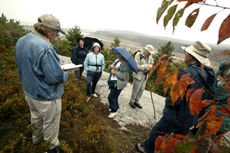Weekend of events to celebrate Bates-Morse Mountain
A play, a special presentation and a hike this week will continue a series of events celebrating the 25th anniversary of Bates College’s stewardship of the Bates-Morse Mountain Conservation Area, 600 acres of land that include Maine’s last undeveloped barrier beach.
Joined by partners from the Phippsburg region, where the conservation area is located, and from Maine’s environmental community, the college is offering three seasons of field trips and other events honoring its involvement with this tract comprising dunes and shore, forest, rocky upland and salt marsh.
The week’s events are all open to the public at no charge. For more information, call Judy Marden at 207-786-6078.
Playwright-actress Kaiulani Lee performs her solo play A Sense of Wonder, telling the story of nature writer Rachel Carson’s life and work, at 7:30 p.m. Thursday, Oct. 23, in the College Chapel, College Street.
At 8 p.m. the following day, in Schaeffer Theatre, College Avenue, Bates students, alumni and faculty with ties to the BMMCA offer “The Impact of a Special Place: The Bates Connection to Morse Mountain.” Participants in this wide-ranging presentation include:
Professor Robert Thomas, of the Bates biology department, who will discuss nature photography;
Leah McDonald ’02, who created a self-guiding BMMCA nature trail;
Barbara St. John Vickery ’83, a member of the family that leased the land to the conservation area corporation and the director of conservation programs for The Nature Conservancy;
and Michele Dionne ’76, an early researcher at BMMCA and the director of research at the Wells Estuarine National Reserve. The presentation inlcudes an exhibit of photographs by Emma Sewall (1836-1919).
Finally, a guided hike at Morse Mountain will lead through the conservation area to Seawall Beach starting at the parking lot at 1:30 p.m. Saturday, Oct. 25.
Serving as a nursery for juvenile fish, a haven for rare plants and birds including the least tern and piping plover, and a peaceful sanctuary for all, the conservation area is visited by Bates students and faculty, naturalists from all over and the public. People from Bates use the land as a living laboratory for research and documentation, a sort of secondary classroom for science courses and student projects.
In 1978, the St. John family deeded this land to the Bates-Morse Mountain Conservation Area Corporation, with conservation easements held by The Nature Conservancy requiring that it be preserved in its natural condition for all time. Bates holds a 50-year lease on the land in exchange for providing stewardship.
The college is committed to preserving, protecting and gently using the area as a source of learning and inspiration. With European settlement of the land dating back to the mid-17th century, the conservation area’s custodians are also working to reverse some impacts of the human presence and return parts of the land, notably the salt marshes, to their pre-Colonial state.
The BMMCA anniversary series is co-sponsored by the Philip J. Otis Fund at Bates. Established by Margaret V.B. and C. Angus Wurtele, the fund commemorates their son, Philip, of the Bates class of 1995, who died attempting to rescue a climber on Mount Rainier in 1995. Otis was concerned about nurturing a sense of responsibility for the natural environment, and the annual lectureship focuses on environmental issues and the spiritual and moral dimensions of ecology.



